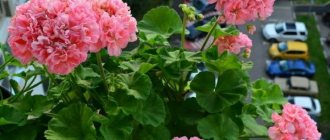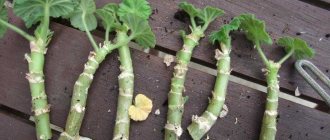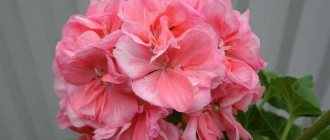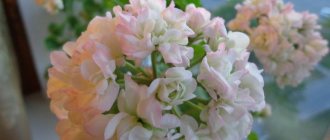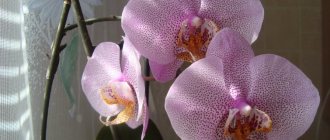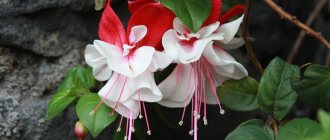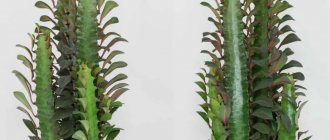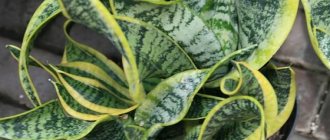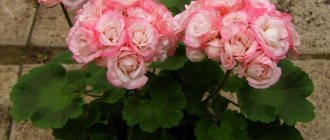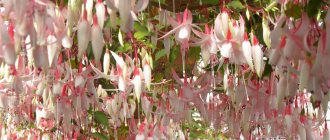Pelargonium ivy-leaved is familiar to many. Upright bushes can be seen on the windowsills of houses or growing in the garden, but hanging climbing varieties are only gaining popularity among gardeners. One of the most famous varieties of ampels of this plant is called ivy-leaved pelargonium. You can decorate your balcony with it or plant it on the window. Often this particular variety is used to create vertical gardening. The universal variety can be grown in the garden on a regular flat area. Here it will look like a dense green carpet with bright, catchy colors.
More information about the ampel Pelargonium ivy-leaved
This type of pelargonium also belongs to the Geraniaceae family, but it is distinguished by the flattened shape of the leaf blade. Its leaves have a five-lobed shape, like ivy. The surface of the sheet plate is smooth and glossy.
In nature, ivy-leaved pelargonium has very strong leaves that can break through rocky soil. When grown indoors, they become softer and smaller.
The shoots of the plant are long and curly. Since the stems hang down, it is best to grow pelargonium in pots or cache-pots. The inflorescences of this species are similar to umbrellas, because one bunch can contain from five to nine flowers. The flowering period of the plant is not too long. It starts in spring and ends in July. The color range of inflorescences is also rich. On sale you can see planting material with almost any shade of flowers. Flowers may be unevenly colored, for example, have spots, stripes, borders, inclusions that differ from the main color.
Pelargonium and geranium are often confused, but they are not the same plant, they simply belong to the same family. Pelargonium was brought to European countries at the beginning of the 17th century from Africa. The length of an adult plant can reach one and a half meters, so it is better to place the flower on a stand or grow it on a balcony. In nature, this species can be found in Italy, Spain or China. It prefers to grow in hot or temperate climates.
Among the plant species you can find varieties with double flowers, which are shaped like roses or tulips. Usually the inflorescences are collected in umbrellas, and the flowers themselves have bright, rich colors. They can combine two tones.
Many varieties of hanging plants are created through selection, for example, the result of crossing ivy-leaved and zonal pelargonium was the group of hybrid varieties Toskana. These include Malaika, Marlen, Teske, Nixe. No less known to gardeners is the Tornado hybrid group, which can bloom for up to six months.
Description of ivy-leaved pelargonium series Tuscany (Toscana): Bernd, Edwards, Renske
Pelargonium was born in South Africa, and in Russia in the eighteenth century it won the hearts of aristocrats and became the decoration of rich mansions. During the breeding process, the plant adapted to the climate, and therefore is highly popular.
Appearance and characteristics of pelargoniums
There are about 250 varieties of Pelargonium Toscana. The most favorite plants of gardeners are Bernd pelargonium, Regina species, Tammo and others.
The stem of the flower can be straight or curly, and the leaves can be carved and terry. But the defining characteristic feature is the inflorescences themselves - bright or soft pink flowers of 4 petals, which are collected together into a bouquet.
Royal pelargonium is valued for the unusual color of its semi-double petals.
! Sometimes in descriptions the flower is called “Tuscan geranium”, but this is wrong, pelargonium just belongs to the geranium genus.
Description of popular varieties of pelargonium from the Toscana series
Pelargonium PAC Viva Madeleine, Carolina and other varieties
Pelargonium Tuscany is especially popular. This is due to the fact that it can bloom all year round and is unpretentious in home and garden conditions. The lush bush not only decorates with delicate terry umbrella inflorescences, but also exudes a pleasant spicy aroma. The most popular varieties:
- Pelargonium Toscana Bernd. It is distinguished by large semi-double flowers up to 3.5 cm each and a rich cherry color. It is similar to the Tammo variety. Pelargonium Tuscany Bernd can be planted indoors, on the balcony or in the garden.
- Pelargonium Edwards Tuscany. It also has tight inflorescences and a lush shape. Pelargonium flowers of the Edwards Toscana variety resemble rosebuds.
- Variety Tuscany Renske. It has compact bushes with double burgundy flowers. The flowering period is from early spring to late autumn.
- Toscana Castello. Named after the beautiful castle, it amazes with its grandeur. Widely branched, colors range from white and soft pink to purple.
- Toscana Hero. Gardeners call this variety standard. The small size of the Hiro stem is combined with rich flowering.
Delicate bouquet of Edwards pelargonium inflorescences
Planting and further care of ivy-leaved pelargonium Tuscany
Caring for ivy-leaved pelargonium Tuscany is simple. Planting technology may vary depending on the location of cultivation, since the crop grows well in the room, on the balcony and in the garden.
Planting a plant
Pelargonium SOUTH Shukar, Aksinya, Ireland and other varieties
The flower prefers relatively hard soil, which combines turf and leaf soil, peat and sand. It is important to take care of the looseness and filling of the soil with oxygen.
Watering, spraying and fertilizing
Before and after planting, the plant is watered abundantly for two weeks. Then, in hot weather, it can be watered every other day, and in cold weather - 2 times a week. It is better to install drainage under the pot to absorb excess moisture. Spraying the flower is necessary only on very hot days.
Note! To bloom for many months, you should fertilize the flower with universal compounds at least once every two weeks.
Trimming
The procedure is required to achieve maximum flowering duration. There are three types of pruning:
- – it is done in early spring; you can safely trim the long stems and give them shape, since new ones grow very quickly.
- Autumn - removal of dry leaves and diseased stems.
- Pinching throughout the year.
How to prune a flower
Reproduction
Reproduction is carried out in three ways: seeds, cuttings and dividing the bush.
Diseases and pests, ways to combat them
Diseases of zonal pelargonium manifest themselves in yellowing, rotting and dryness of leaves. The most common reasons: lack of light, too much watering, poor ventilation and insufficiently clean substrate.
Important! Treatment is carried out by quickly removing the diseased part of the flower and eliminating the cause of the disease.
Frequent pests of the plant are aphids and whiteflies. When they are detected, insects are first collected by hand, then the flower is treated with an insecticide solution.
Pelargonium Toskana, which is so often called geranium, is a real decoration of the home or garden. Lush bushes with dense umbrellas of flowers look luxurious and impressive.
Source: https://pocvetam.ru/komnatnye-rasteniya/tsvetushchie/pelargoniya-toskana.html
Most popular varieties
Several species of ivy-leaved pelargonium have now been selected. Among them, gardeners give preference to several varieties because of their decorative properties.
Angel
This plant is not too tall. It can grow up to 30 centimeters in height. Outwardly, it looks like a pansy. Flower growers often grow it at home. This variety is quite hardy compared to others. and it is not difficult to care for. To make the composition look more decorative, you can plant several flowers at once in one container. So, the bushes look more lush.
Tuscany Eva
This variety of flower is most loved by gardeners because of its short growth and beautiful snow-white flowers. The height of the bush reaches half a meter. It begins to bloom in May and pleases its owner with flowering until the frost.
Tornado
This variety is the result of the work of Dutch breeders. Bushes of the "Tornado" variety are low, about 30 centimeters. Bright red buds bloom on it. In gardens and apartments it can be seen growing in flowerpots and hanging baskets.
PAC Pink Sybil
This variety is valued for its double pink inflorescences. Externally, such pelargonium can be mistaken for a decorative rose. PAC Pink Sybil blooms early, but its flowering period itself is long.
PAC Sally
This species is characterized by lush flowering. The plant has a large number of dark burgundy flowers with a terry surface on the bushes. Inflorescences can merge into entire caps of flowers.
Toscana Josina
Characteristic features of the variety: double flowers with a rich lilac hue and an abundance of small two-color leaves.
Toscana Okka
The plants will delight their owner with bright orange flowers collected in inflorescences. On the petals of Toscana Okka flowers. as if painted, white stripes.
Toscana Malaika
This is an early blooming pelargonium variety with purple-pink inflorescences. The Toscana Malaika bush blooms profusely. No less popular for breeding and growing are the varieties “Amethyst” or “Rhapsody”.
Application in landscape design
Ivy-leaved pelargonium deserves a special place in garden and indoor landscaping. Its hardiness, low watering requirements and ability to withstand direct sunlight make it an ideal plant for vertical gardening in containers and flowerpots. Strong shoots will not be broken by the wind in balcony compositions, and the ability to weave along the support allows them to be used for small trellises. It looks great indoors all year round and retains its green leaf mass in winter.
How to arrange geranium-pelargonium in the garden plot
Why do professional designers create the most beautiful gardens? The fact is that they think through the design project in advance and use various decorations for the garden. To make you proud of your suburban area at all times of the year, consider a set of plants that will bloom at different times. Decoration is also very important, let's see how you can decorate a geranium.
How to incorporate geranium into landscape design:
- Ivy geranium is distinguished by its creeping nature. This is a flower that will look great on alpine slides and gazebos. Another interesting technique is when a clay jug is placed on its side in the garden, and creeping pelargonium is planted next to it. Thus, it seems that beautiful flowers have poured out of the jug.
- Rose geranium is incredibly beautiful. It can be placed in a decorative wooden cart. It will seem that the florist is bringing his harvest for sale.
- You can plant creeping forms of plants on the balcony. In this case, the plant will entwine its frame, and from the street it will look amazing.
To create a landscape design for your garden, you can collect ideas from all over the world. In this case, you will be able to create a unique design on your site or window that will amaze everyone with its beauty.
Geranium is a plant that blooms with beautiful fragrant flowers. You can and should plant it in your suburban area, but you need to know how to do it correctly. In this case, you will get a chic landscape design.
Video tips from landscape designers
Care
For active growth and long-term flowering of the bush, you need to properly care for it. Growing ampelous pelargonium differs from geranium.
Light
This is one of the crops that is not afraid of the sun and burns. Ampelous pelargonium prefers an abundance of light, which is necessary for the development of the plant. It is not recommended to place the pot with it on the north window. It can only fully bloom on the south side. If this is not possible, then the flower needs to be illuminated with artificial light.
Temperature
On hot days, the temperature in the house should not rise above 32 degrees, otherwise the bush will simply burn. In winter, the air should warm up to at least 15 degrees. But even at this temperature, the bush can continue to bloom.
Watering and spraying
The plant is not afraid of dry air in the room, it does not need to be sprayed, but on hot days it needs to be watered every day. But at the same time, the flower has an extremely negative attitude towards flooding with water. Its leaves quickly rot when moisture accumulates. To prevent this from happening, water it at the root so that water does not flood the plant.
Overflows of water are worse for her than dry soil. In summer, the plant is watered a little every day. But if the soil at a depth of three centimeters has not had time to dry since the last watering, then watering must be rescheduled; even on the hottest days, the bush is not sprayed.
In winter, watering is reduced and depends on the temperature in the room. Watering once a week in winter is usually sufficient.
Priming
The best substrate for an ampel would be loose soil with an abundance of nutrients. To prepare it, you should take sand, peat and turf in equal parts, and thoroughly mix the ingredients together.
Such soil retains water and does not allow it to stagnate in the root area. When growing a house, a drainage layer must be laid out at the bottom of the container. The container for the ampel should be such that the stems can hang freely. Typically, flowerpots or pots placed on balconies are used for these purposes.
Fertilizer
It is necessary to feed the climbing plant during the entire flowering period. It is recommended to fertilize the bushes once every seven days, enriching the soil with humus or mineral compounds. The rest of the time, the amount of fertilizing is reduced and the flower is fed approximately once every 20 days. In spring and summer, the plant should be fed with compounds containing potassium and phosphorus. At other times of the year, the soil should be enriched with organic fertilizers and humus.
An alternative fertilizer can be “milk water”. Milk is simply diluted with water in a ratio of one to two. This solution saturates the leaves and other parts of the plant with nutrients.
Bush formation
To ensure that the bush always remains lush and dense, it should be pruned. It is best to do this in the spring, when the plant has just “woke up”. It is necessary to cut off all branches, except those that have two to four nodes.
Cutting is done only with a knife. You cannot pick them with your hands or break them off, because the flower quickly begins to rot. In case of severe injury to the plant during pruning, the “wounds” must be treated with crushed charcoal. As a result of the procedure, the base of the cutting should remain on the bush, and not on the cut leaf. Pruning and shaping the bush allows you to give ivy-leaved pelargonium the desired shape and remove diseased branches.
Caring for ampelous geraniums at home
Caring for ampelous geraniums is not difficult. Despite the fact that the plant’s homeland is Africa, it has perfectly adapted to home conditions and to outdoor conditions in the summer.
Selecting a location
The most important thing for planting geraniums outside is the composition of the soil. It is the well-chosen soil that will give strength to the flower. The soil must be free of stagnant groundwater, this way the roots of the flower will be protected from rotting.
For your information! Another important point is that geranium does not like clay and loamy soil, so places with such soil are not suitable for planting a flower.
Soil requirements
Soil that is optimally suitable for planting ampelous pelargonium should have such characteristics as looseness, lightness, air and moisture permeability. A mandatory element of the substrate that provides all these requirements is peat and coarse sand. You can buy ready-made soil in a store or prepare it yourself: mix peat, sand, turf, and leaf soil in a 1:1:1:1 ratio.
Temperature
Pelargoniums appreciate warmth during the summer - the flower is left in a warm place with a temperature of 20 - 25 ° C. In winter, the flower should be given a cool rest period and the temperature should be lowered to 15°C . Does not tolerate frosts. During the winter months, the flower should not be exposed to temperatures below 8–10 °C.
Lighting
Ivy-leaved pelargonium prefers window sills with bright sunlight. A south or southwest window is suitable for it. Direct sunlight will not burn the plant. In winter, it is necessary to maintain good lighting. Lack of lighting in winter will lead to elongated shoots and pale leaves. Many leaves will fall off, exposing the stems.
How to water and what to feed?
The need for moisture is determined by the top layer of soil: when it is slightly dry, it is time to water. Do not allow the earthen clod to dry out and water to stagnate on the soil surface.
In summer they water more often, in winter - less often. There is no need to spray the plant, otherwise the leaves will rot. At any time of the year, the ampelous geranium is ventilated, but so that there are no drafts.
Feeding begins in early spring and stops at the end of summer. The frequency of fertilization is once every 10-14 days.
The regularity and composition of fertilizing affects the quality and duration of flowering.
When ampelous geranium just begins to grow, it needs nitrogen to form green mass. Bud formation and flowering are periods when the plant requires phosphorus and potassium.
It is better to feed with ready-made fertilizers for ampelous pelargonium: the components in them are selected in the correct proportion. Purchased products alternate with homemade ones. For example, you can water:
- With diluted milk.
- Infusion of onion peel.
- Settled water with added iodine (1 drop per 50 ml). Carefully water the soil with iodine solution closer to the edge of the pot.
Feeding ampelous pelargonium for lush flowering
During the flowering period, geranium needs feeding. You can help the flower during this period with the help of various fertilizers, which are added to the soil throughout spring and summer.
In this case, a complex of mineral fertilizers comes to the rescue. Also, flower growers sometimes use milk as a top dressing. But you should be careful; first, just like other fertilizers, it must be diluted with water.
Lush flowering of ampelous geranium at home after proper care
Important! Organic fertilizer is not suitable for hanging geraniums.
For fertilizer purposes, substances such as phosphorus, potassium and magnesium sulfate are also used, which also need to be diluted with water.
Pruning and shaping the bush
Why do you need to prune geraniums? This question is most often asked by novice gardeners, because the flower is already growing, why break it off? Pruning pelargonium is necessary so that the bush has a neat appearance. It also helps the flower not to waste extra effort on stretching it to unnecessary lengths. Thus, the plant gives all its energy to flowers and lush leaves. In addition, pruning allows you to obtain cuttings for flower propagation.
Trimming
Important! Pruning can only be done on an already mature bush. Young plants may be damaged by this method of creating a flower shape.
All about pruning and pinching pelargonium
The main difference between pruning and pinching is that the former is considered a drastic way of changing the shape of a plant by removing entire branches. This is necessary so that the flower is formed in the form of a bush, otherwise, if pruning is not done and the flower is allowed to grow the way it wants, the branches will stretch out, and the plant itself will produce a minimum number of flowers.
How a flower propagates: by seeds
This method is the longest and most labor-intensive, so in practice it is rarely used. In addition, when grown from seeds, varietal qualities deteriorate. Planting seeds is done in the spring. Planting material is purchased in advance at the store. A drainage layer of expanded clay is formed in the growing pots. Soil is poured into the container on top and watered.
Before planting, the seeds are soaked for 24 hours in a solution of a growth stimulator. After this, they are laid on the ground and lightly sprinkled with earth. The soil is sprayed from above and covered with film, putting it in a lighted place with a temperature of about 24 degrees. After eight to ten days, the first seedlings appear. After the third leaf, the seedlings are transplanted into separate pots.
Cuttings
This method of reproduction is considered effective. In spring, it is necessary to prepare layering. They are cut from the bush. Each cutting must be at least seven centimeters long and have at least two nodes. Layers are not placed in water, as the plant may rot. They are immediately rooted into the ground. The cut should be lubricated with a stimulator for the growth of the root system.
You need to make drainage in the planting container, fill it with soil and water it. Layers are buried in the ground so that the first node is above the substrate level. The cuttings are covered with a cut plastic bottle, and the container is placed in a bright, warm place. After three weeks, the cuttings begin to form roots. The first leaves appear on the shoots and are pinched off. Usually, if the procedure is carried out in spring, the plant begins to bloom in the first season.
Planting, transplanting and propagation
Reproduction and transplantation of ampelous pelargonium, like any other, does not require special skills. There are several ways to propagate geraniums - dividing the bush and cuttings is the most accessible method. Propagating flowers by seeds is more labor-intensive.
Transplanting ivy-leaved pelargonium
Replant the plant in nutrient soil containing leaf humus, peat and some coarse sand for drainage.
Young bushes require replanting every year , as their root system develops and takes up more and more space. The signal to replant such plants will be the tips of the roots protruding in the drainage holes of the pot. Each time when replanting, the size of the pot for young plants is increased by 2 - 3 cm . in diameter.
How to plant a plant in the garden
It is best to plant the plant in open ground when the soil is well warmed up. At this time, the air is usually well warmed up, and the frosts have stopped.
If a pot is selected for growing a plant, then you need to know the capacity of the pot. You should not take containers with too large a volume. It should maximally exceed the volume of pelargonium roots by one and a half centimeters around the perimeter. The bottom of the pot should be lined with brick or pebble drainage.
After this, you need to prepare an earthen mixture, which consists of turf, sand, peat and humus. Half of the substrate needs to be poured into the pot, the bush should be lowered, and then the soil should be poured into the voids. The earth should not be compacted too much. After this, the bush is watered so that water does not get on its leaves. You can simply spray the soil with a spray bottle. If ivy-leaved pelargonium is planted in a garden bed, then you need to make several holes with an interval of at least 20 centimeters. The planting material goes deep into them no more than two centimeters. This way, root shoots will form faster.
Currently reading:
- Planting to decorate the site with three types of coniferous trees
- Choosing cucumbers for open ground according to your preferences
- Varieties, planting and care of perennial rudbeckia
- Exquisite juncus (rumen) spiral-shaped in the interior
Share the news on social networks
About the author: Vladimir Petrovich Efremov
Chief agronomist of the limited liability company “Association of Peasant (Farm) Farms “Kuznetsovskaya””, Ilovlinsky district of the Volgograd region.
